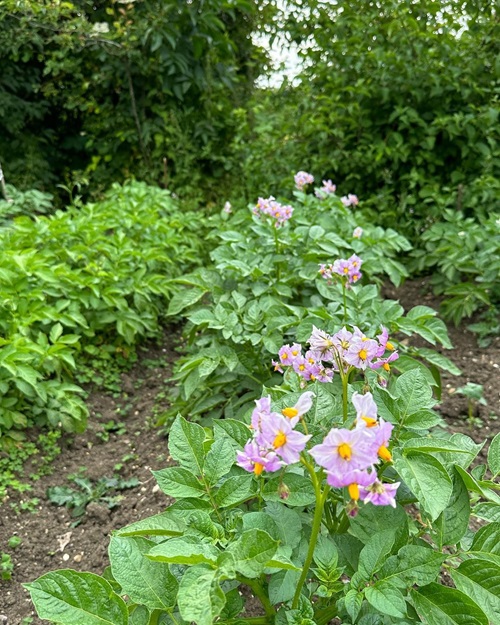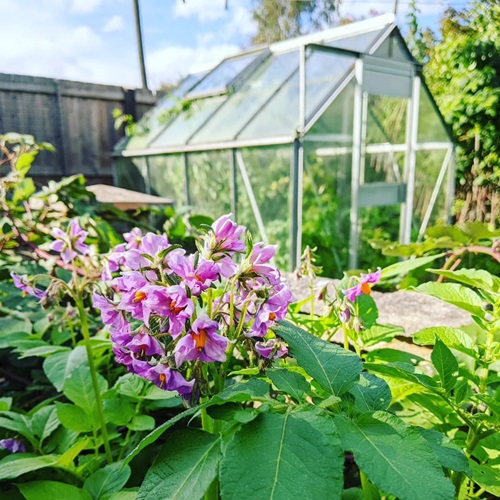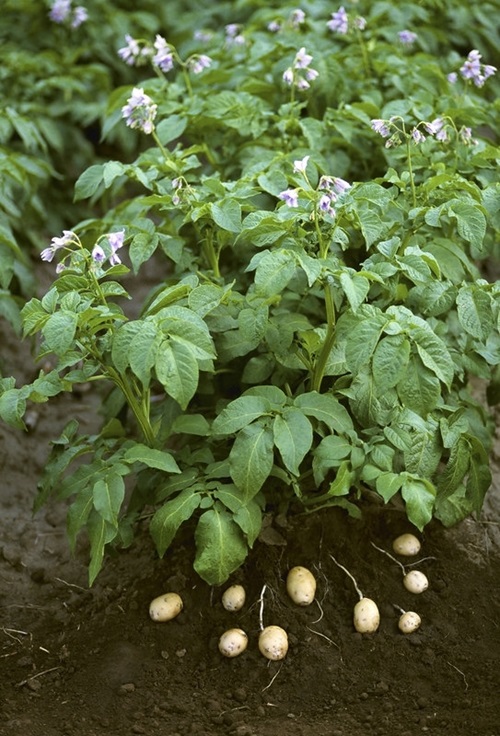Not sure What to Do with Potato Flowers? Don’t worry! You are not alone! We will give you every bit of detail you need!
The mysterious Potato Flowers are a spectacle that sparks curiosity and debate among gardeners. These captivating blossoms, often overshadowed by the coveted tubers lying beneath the soil, present an intriguing question: What to Do with Potato Flowers? Well, time to find out!
Check the Uses and Benefits of Sweet Potato Flowers here
Potato Flowers
Potato flowers are often an overlooked aspect of the versatile potato plant. These blossoms are surprisingly beautiful and come in a variety of colors including white, lavender, and pink, depending on the potato variety.
The flowers generally have a star-shaped form with five petals and yellow stamens at the center. They appear in clusters on slender, upright stems and are roughly 1 to 1.5 inches in diameter. Some potato varieties may also produce small, green, tomato-like fruits after flowering, which contain seeds.
Fragrance
When it comes to fragrance, potato flowers usually have a mild, subtle scent. The aroma is not particularly strong or overpowering, which is why it’s often unnoticed. However, some people describe it as slightly sweet or earthy.
Check Kennebec Potatoes Growing Tips and Facts here
What Do Potato Flowers Indicate?

1. Indicator of Maturity
When a potato plant starts to flower, it is generally an indication that the plant is maturing and tuber formation is underway.
The appearance of flowers signals that the plant has reached a stage where energy is being directed both above ground for flowering and below ground for tuber growth.
2. Variety-Specific Behavior
It’s important to note that not all potato varieties flower, and some may produce flowers but no fruits. Flowering can be influenced by various factors such as soil conditions, climate, and overall plant health.
Some early-season varieties may produce smaller tubers at the onset of flowering, while late-season types may need additional time for the tubers to reach full size.
3. Harvest Timing
The flowering stage is often used as a rough guide for harvest timing, particularly for “new potatoes,” which are young, small, and tender. However, for fully mature potatoes, it’s generally better to wait until the plant’s foliage starts to yellow and die back.
4. Not a Guarantee for Tubers
While flowering is a positive sign of plant maturity, it does not necessarily guarantee that the plant is producing tubers or that the tubers are ready for harvest. Some plants may produce flowers but fail to produce a significant amount of tubers due to poor soil conditions or other environmental factors.
Caution: If your potato plant goes beyond flowering to produce small, green, tomato-like fruits, exercise caution. These fruits contain solanine, a substance that is toxic if ingested.
What to Do with Potato Flowers? Remove or Keep Them?

1. Keep Them, If You Like
In most cases, potato flowers are harmless and may even add a bit of visual interest to your garden. They generally indicate that the plant is healthy and that tuber formation is occurring. If you enjoy the look of the flowers, there’s no immediate need to remove them.
2. Consider Removal for Energy Conservation
However, some gardeners believe that removing the flowers can help the plant direct more energy into tuber development. The theory is that by taking away the flowers, you eliminate one of the outlets where the plant expends its energy, thereby channeling it into producing larger or more numerous tubers.
It’s worth mentioning that there’s no substantial scientific evidence to strongly support the notion that removing flowers significantly impacts tuber yield. Most commercial growers don’t remove flowers as part of their regular practices.
Discover DIY Potato Pots to Grow Potatoes Without Digging here
Potato Flowers – FAQs

1. Do All Potato Plants Produce Flowers?
No, not all potato plants flower. The appearance of flowers depends on various factors such as the potato variety, growing conditions, and overall plant health.
2. What Do Potato Flowers Look Like?
Potato flowers typically have five petals and come in shades of white, pink, or lavender, depending on the variety. They have yellow stamens at the center and are about 1 to 1.5 inches in diameter.
3. Do Potato Flowers Have a Fragrance?
Potato flowers generally have a mild, subtle scent. While not overpowering, some describe it as slightly sweet or earthy.
4. What Does Flowering Indicate?
The appearance of flowers usually signals that the potato plant is maturing and that tuber formation is underway. However, flowering is not a foolproof sign that the tubers are ready for harvest.
5. Should I Remove the Flowers?
This is largely a matter of personal choice. Some gardeners remove the flowers to potentially direct more energy into tuber development, although there is no strong scientific evidence to support this practice.
6. Are Potato Flowers Edible?
Potato flowers themselves are not commonly consumed and are not recommended for eating. Always exercise caution and consult credible sources before ingesting any plant parts that you’re not familiar with.
7. Are the Green Fruits Edible?
No, the green fruits that some potato plants produce after flowering are toxic and should not be eaten. They contain a substance called solanine that can be harmful if ingested.
8. Can You Grow Potatoes from the Seeds in the Fruits?
While it is technically possible to grow potatoes from true seeds found in the fruits, the resulting plants may not be identical to the parent plant due to genetic variability. Most potatoes are grown from tubers to maintain desired characteristics.
Do Flowering Potato Plants Require Special Care?
Once the potato plant starts flowering, it’s crucial to maintain consistent watering and to avoid water stress, as this is a critical phase for tuber development.
9. Is Flowering Related to Pest and Disease Resistance?
Flowering itself is not an indicator of a plant’s resistance to pests or diseases. However, a healthy, flowering plant is generally a sign of favorable growing conditions.


